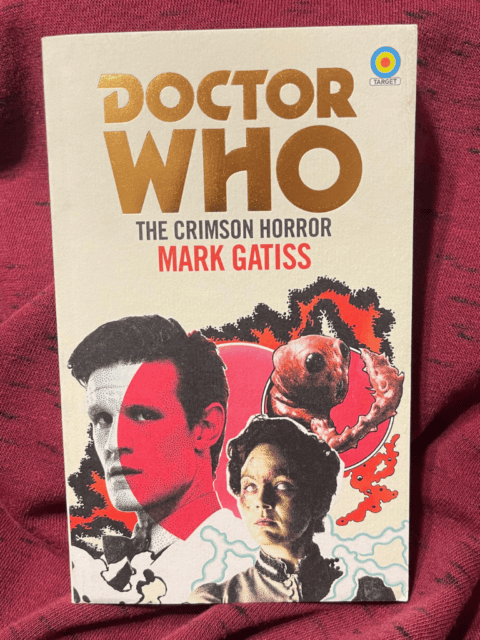Book Review: ‘Doctor Who: The Crimson Horror’ by Mark Gatiss

The Doctor is in Victorian England once again. And shockingly it’s not in London! No, this time he’s in Yorkshire. People keep turning up in the river. Dead. And not just a normal drowned rat kind of dead. Oh no, these people look as if their last moments were filled with absolute terror, and their skin has turned a bright, glowing shade of red. What could possibly be causing this so-called crimson horror? The Doctor and his friends need to figure it out and fast before they become the next victims in Mark Gatiss’ Doctor Who: The Crimson Horror.
[Warning: My review of Doctor Who: The Crimson Horror contains some spoilers!]
Revisiting an Eleventh Doctor episode with Mark Gatiss
Doctor Who: The Crimson Horror is based on an episode of Doctor Who which originally aired on May 4th, 2013. Mark Gatiss wrote both the book and the original episode of Doctor Who. While the Doctor often meets up with old friends during his travels, Gatiss thought that some backstory was needed for his friends this time around.
The entire opening third of the book was dedicated to how Jenny, Madam Vastra, and Strax originally met the Doctor. They stopped an attempted assassination of the Prince of Wales. Sorta, turns out he wasn’t the actual target. But they met and became friends and that’s what matters. After Jenny relates this story it’s time to focus on the actual crimson horror for which the book is named. Madam Vastra (and Jenny by association) is hired to find out just what is happening at the Sweetville commune that seems to be at the center of the crimson horror mystery.

As they begin investigating they realize that their old friend the Doctor is also caught up in the mess. Mrs. Gillyflower, the lady in charge of Sweetville, isn’t someone to trifle with either. She’s mean as hell and more than a little crazy, never a good combination. Getting in and exposing the truth might just be more than they can handle.
Doctor Who without much Doctor
Gatiss decided to tell this adventure mainly from Jenny’s point of view. In fact, the whole adventure is related to us through Jenny’s eyes, but she occasionally incorporates other people’s points of view to fill in events she wasn’t present for. This allows the Doctor’s entrance to the story to be a surprise (even though we know he’s going to show up eventually, I mean his name is on the cover). This leaves us uncertain of when the Doctor arrived and how much he did before Jenny found him. But that doesn’t matter. Jenny’s story and everything that she and Madam Vastra do give us a more than interesting story.
One benefit of having two different adventures in one story is that they both are very concise. There is a lot of action in both adventures but no extra fluff. It makes the adventures more exciting and intense. It also makes them very enjoyable. I was especially happy with this setup because I often find British entertainment a little slow and, well, boring but by streamlining the two stories Gatiss packs a whole lot of fun into a small package.
But was it aliens in Doctor Who: The Crimson Horror?
So before I ever read my first Doctor Who book I was told “It’s always aliens”. And even when it really looked like it must be something else, it has always turned out to be aliens. But this time I’m not so sure it was. Without giving away who or what caused the crimson horror, it seemed to have a terrestrial source. Even the Doctor never labeled it as an alien species. Instead, it seems that the culprit was a creature out of time. A survivor that was millions upon millions of years old (an original specimen or an offspring that managed to stay hidden is unclear). But still an earthly one.
As odd as it is for me to say, it was actually a little jarring because I really expected it to be an alien. Not only is the mantra “it’s always aliens” stuck in my head but the clues added up to an alien. I’m not complaining, variety is good, but it just left me confused (I almost called up my Doctor Who source to say “What was that?!”, but I didn’t).
Now there was an alien in The Crimson Horror. Madam Vastra’s associate, Strax is an alien. And not exactly a friendly one, although he does help her with her investigations. And Madam Vastra herself, while not an alien, is not quite human either. In fact, she serves as some early foreshadowing for the ultimate cause of the crimson horror. But she is fully on the side of good, no dead bodies of innocent people are left in her wake. She’s only interested in helping us humans. So there’s still an alien, even if it wasn’t aliens this time.
A different Doctor story but worth checking out
The Crimson Horror is different from the traditional Doctor Who story in a few ways: it’s not told from the Doctor’s point of view, in fact, it barely features the Doctor, it has two stories instead of one, and it isn’t aliens. But all of these differences won’t stop someone from enjoying the story. There’s plenty of confusion and excitement, just like a normal Doctor Who adventure. The Doctor, when he’s in it, still has his trademark confidence and doesn’t bother to explain anything he does, like always. Fans will certainly see the familiar things they love about Doctor Who mixed in with the new elements.
And let’s face it, after 60 years, things have to be switched up from time to time to keep them interesting. Otherwise, fans wouldn’t keep coming back. And this story will keep fans coming back. It has everything they love about Doctor Who plus some new twists. It’s exactly what a franchise needs to stay relevant. So go ahead and revisit this episode in a new format, it’s worth it.
Rating: 8/10
Doctor Who: The Crimson Horror by Mark Gatiss is available now! Will you be checking this book out? Let us know on Twitter or in The Cosmic Circus Discord.
Book Review: Doctor Who: The Fires of Pompeii by James Moran



